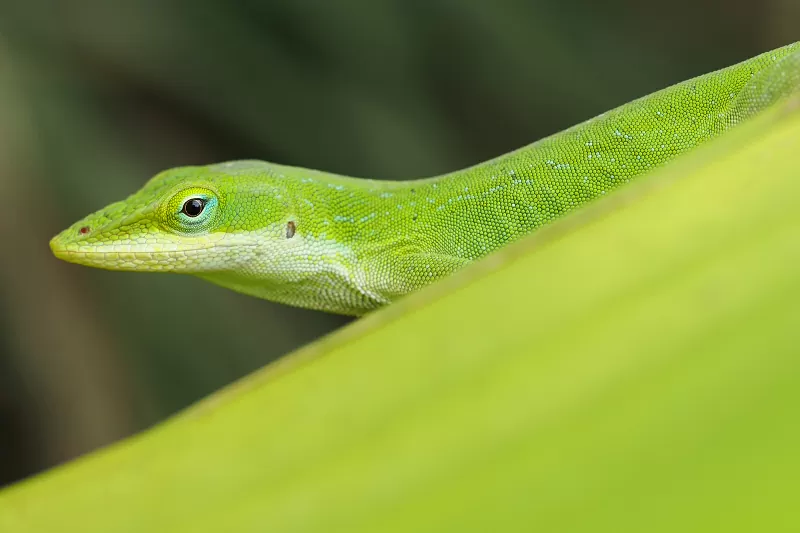
Description:
Scientific name: Anolis carolinensis
Life span: 5 years- up to 8 years
A species of anole lizard that lives in trees is called a “green anole,” or Anolis carolinensis. A tiny to medium-sized lizard with a lean physique, the green anole. The head is long and pointed, with smaller ridges on the top of the skull and larger ones between the eyes and nostrils. In order to make climbing easier, the toes include adhesive pads. They are sexually dimorphic, with the males being 15% bigger. A population of adult males can be divided into a heavyweight and a lightweight morph. The female dewlap (throat fan) is lighter in color and three times as big as the male’s, which is also brilliant orange to pink. The dewlap is quite uncommon in female Anolis carolinensis and is typically pink (more orange-red in A. sagrei). The dewlap’s hue varies and appears differently to reptile and human eyes.
Native Region/Habitat
Native to North America, this species is primarily found in the subtropical southeast regions of the continent. Anoles have been recorded in Tamaulipas, Mexico, but it is most likely an introduction.

Behavior:
Extremely territorial animals are male anoles. Some people have even been seen squabbling with their own reflections in mirrors. To protect his area, the male will battle other males. The anole will compress his body, stretch the dewlap, inflate a dorsal ridge, bob his head, and make an effort to chase the competition away when he sees another male. Anoles will fight by biting and scratching each other if the competing male comes any closer. Moreover, studies have demonstrated a favorable relationship between bite force and dewlap size. According to one study, during the breeding season, testosterone concentrations in heavyweights were 50% greater than those in lightweights. Higher biting forces of heavyweights appear to be connected with disproportionately large heads and dewlaps. In comparison to their lighter conspecifics, those with darker colorations will pick lower perch positions.
Care As a pet/In captivity:
Housing:
Anoles can live in a terrarium or tank that is rather small. A single or pair of anoles can be kept in a 10-gallon aquarium. Of course, a bigger tank is ideal, and you need a lot of space if you’re housing numerous anoles.
Only one male anole should be kept per tank. As long as the tank is spacious enough, there are lots of basking sites, and there are numerous places to hide, females will get along just fine. Due to their ability to squeeze through extremely small spaces, green anoles require a lid that fits tightly.
For green anoles, a humidity level of between 60 and 70 percent is required (use a hygrometer to monitor these levels). Typically, you can accomplish this by daily spraying the tank’s interior. There are misting systems, but they are extremely pricey. Try covering a portion of the tank’s top or adding more live plants to the enclosure if you are having trouble keeping the humidity level. Moreover, misting provides the anoles with drinking water because they frequently refuse to drink from a dish (they will lick droplets of water off the misted plants like chameleons).
Heat and Lighting:
Provide a thermal gradient of 75 to 80 F (24 to 27 C) with an 85 to 90 F basking area during the day (29 to 32 C). It works best when under-tank heaters are used in conjunction with a basking light on one side of the tank. By testing the temperatures in various locations within the tank, you can confirm that the proper temperature gradient is being given. The range of the nighttime temperature is between 65 and 75 F. (18 to 24 C). Use heating pads, ceramic heating components, or special night heat lights instead of white basking lights to attain overnight temperatures.
In addition to the incandescent basking light, a full spectrum UVA/UVB light needs to be available for 10 to 12 hours each day. Your anole will remain vibrantly colorful, active, and happy by remaining protected from metabolic bone disease with the aid of this special light. Even if the bulb hasn’t burned out, it needs to be replaced every six months, and only a metal mesh screen should be obstructing the light (no plastic or glass).
Food and Water:
Insectivores by nature, green anoles make typically healthy eaters. While crickets can serve as the major food source, it is important to also provide mealworms, wax worms, and other gut-loaded insects. Every other day, feed the anole two to three adequately sized prey items that are roughly half its size. Dusting the insects with a calcium and vitamin supplement is also recommended.
Table





